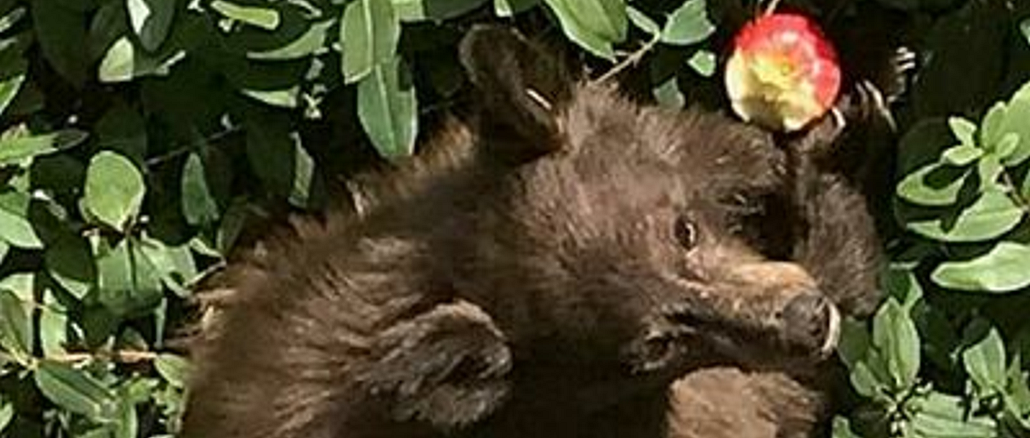
SACRAMENTO, California, March 27, 2021 (ENS) – A small, black bear showed up at a utility worksite in the tiny, tree-lined town of Pollock Pines, California last month. It was alone and possibly sick – lethargic and showing little fear of people. The bear was unmoved by the workers’ attempts to shoo it away by yelling and clapping.
Calls to the California Department of Fish and Wildlife, CDFW, reported the bear had moved into a residential backyard in the heavily timbered mountain region, lethargic – certainly underweight, perhaps dehydrated – and showing no fear of people.
Contrary to CDFW guidance, residents began feeding the seemingly friendly bear with water, apples and strawberries. At one point, the bear jumped into a housekeeper’s open car trunk, prompting attempts to approach it and pet it.

When a CDFW wildlife biologist and warden went to investigate, they encountered a situation becoming more common in the Tahoe Basin and elsewhere around the state. They found a bear too young to be out on its own, “dog-like” in its behavior, completely comfortable around people, picking up an apple to eat in front of them on the backyard patio. Physically and mentally, the bear just didn’t seem quite right, walking oddly, dull and not responsive like a normal bear should be.
The bear was taken to CDFW’s Wildlife Investigations Laboratory in Rancho Cordova for observation and evaluation by veterinarians. Covered in ticks, the yearling female was undersized and underweight for its age at a mere 21 pounds. A bear of that age should weigh closer to 80 pounds, the vets said. Under observation in captivity, the bear displayed intermittent head tremors and a subtle head tilt, troubling signs of neurological abnormalities.
A week of observation and testing confirmed neurologic and behavioral deficits and the bear was euthanized. A post-mortem examination is underway. Preliminary findings have confirmed encephalitis or inflammation of the brain, which would make it the third bear with a neurological disorder due to an inflammation of the brain called encephalitis to be seen in the CDFW’s Wildlife Investigations Laboratory within the past 12 months.
A fourth bear showing signs of neurological abnormalities, this one from Humboldt County, has since been euthanized and encephalitis confirmed in that case as well.
“Any time a wild animal comes into our care, the best possible outcome is a release back to the wild,” explained CDFW wildlife veterinarian Brandon Munk. “That’s just not possible for these neurologically impaired bears. At this point, we don’t know what causes the encephalitis so we don’t know what, if any, health risks these bears might pose to other animals.
“The second-best outcome would be a long, healthy life at a reputable zoo or wildlife sanctuary, but any inflammation of the brain is going to be significant for the individual bear and may have long-term consequences,” Dr. Munk said.
“The few bears like this we have placed do not seem to fully recover, some requiring significant medical management for the life of the bear, which is a huge burden for these facilities that often operate on tight budgets. So neither release back to the wild nor placement in a facility is a good option for these bears,” he said.
The Nevada Department of Wildlife was the first to raise a red flag, alerting wildlife colleagues in California in 2014 to growing encounters in the Tahoe Basin with young black bears with neurological abnormalities. Veterinarians and biologists from the two state wildlife agencies met virtually again in March to share updates on the situation.
Necropsies on the afflicted bears have confirmed encephalitis but the root cause of the disease remains a mystery. During their investigations into the cause, scientists have discovered five novel viruses, previously unknown and unidentified, though their relationship to the condition and the neurological disorders remain unknown.
Complicating matters for wildlife officials, the neurologically dull bears appear friendly to the public. Not fearing people, they may come into contact, and conflict, with humans more often.
One such bear with a prominent head tilt became a social media sensation in 2019 when it approached a snowboarder at the Northstar ski resort, stepping onto the snowboard at one point and curiously sniffing a pant leg as the amused snowboarder filmed the interaction for Instagram. That bear is now three years old. Named Benji, it lives at the San Diego Humane Society’s Ramona Campus.
CDFW received and treated another young bear for neurological abnormalities and placed it with the Orange County Zoo in 2014. These bears serve as something of a cautionary tale as neither fully recovered and both have required significant veterinary care, resources and treatment over time, expenses that are difficult for many wildlife facilities to absorb and limit the placement options for similarly afflicted bears in the future.
California’s black bear population has increased over the past 25 years, says the state Department of . In 1982, the statewide bear population was estimated to be between 10,000 and 15,000. Presently, the statewide black bear population is conservatively estimated to be between 30,000 and 40,000.
Copyright Environment News Service (ENS) 2021. All rights reserved.



